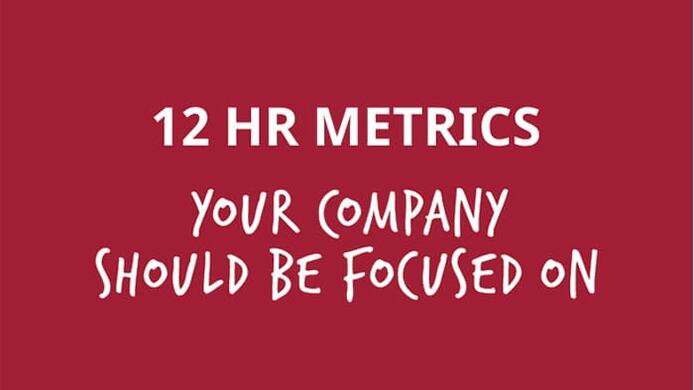Explore our resources for human resource degrees and learn about career options that fit your future.

If you work in human resources, most of your work probably feels intangible. While you can measure how many hours you spend on a given task — researching benefit options or interviewing a new candidate — it’s difficult to pinpoint how your time pays off in a concrete way. Being successful in HR is all about other people’s satisfaction and success.
Believe it or not, there are HR metrics that can be incredibly meaningful to your organization. They’re worth the work, because these measures can result in helpful insights that range from recognizing whether your staff is aware of training opportunities to understanding how valued employees feel.
While it can take time to identify which HR metrics to focus on and set the corresponding benchmarks for improvement, leveraging these data points can improve executive decision-making and employee satisfaction. Because there are so many HR metrics out there, we compiled a dozen of the more commonly used options in the visual below. You’re about to learn not just what each one is, but how it’s calculated and why it matters to your organization.
12 HR Metrics Your Company Should Consider Using
This graphic can help you understand not just how to calculate each data point, but also what you can do to work toward organizational goals.
Recruitment HR Metrics
These data points are all related to attracting talent to your company. Working to improve these metrics can ultimately make the process more efficient and less costly.
1. Time-to-Hire
This metric refers to the number of days between the time a position opens up and the time a candidate actually signs the offer letter. This includes screening applications, conducting interviews and more. The time-to-hire metric speaks to how efficient the organization’s recruitment process is from start to finish while also helping identify how difficult it is to fill certain positions.
2. Cost-per-Hire
Unsurprisingly, cost-per-hire reflects the total financial investment involved in hiring a new employee. A high number indicates the company may need to reevaluate its hiring methods. It could also indicate the need to invest more in recruiting or technology training. Tracking this metric can also be a good way to identify the difference in costs from one time period to the next.
3. Acceptance Rate
Quite simply, this is the percentage of candidates who accept job offers extended to them by the company. This rate measures how competitive your compensation packages are. A low rate could mean it’s time to examine what you offer compared to your competitors. This data can also help determine whether seasonality affects hiring efforts.
Development HR metrics
Every business can benefit from helping existing employees deepen their knowledge, skills and abilities. Each of these measures can help you recognize opportunities to further develop the talent you already have.
4. Readiness
Readiness measures how prepared the organization is to execute the business strategy from a human capital perspective. Based on this definition, you can see that it’s important mostly for roles that are directly tied to achieving organizational goals. Readiness can show which training areas need improvement. It can also indicate the need for better alignment among departments on what it takes to achieve overarching goals.
5. Training Participation Rate
The training participation rate is the percentage of employees who participate in development opportunities. Results will demonstrate the popularity of your training opportunities to help determine if you may want to consider different options, explore a new modality or communicate opportunities more effectively.
6. Average Performance Rating
The average performance rating is the mean performance rating for a specific group of employees. Tracking this metric over time can help you determine how the team is changing and recognize how training program changes are affecting performance. It may be best to calculate this metric by team and then compare numbers across the organization.
Retention Metrics
Most HR professionals are keenly aware of how important it is to encourage employees to stay with an organization. Each of these metrics communicates something different about how satisfied employees are, which significantly influences their commitment to their current workplace.
7. New Hire Turnover Rate
This rate has to do with the number of employees who leave a company while still categorized as new hires, though the exact time period is up to you. Calculating the new hire turnover can help you identify issues with hiring practices and management. A chronically high turnover rate might point toward a gap between expectations and reality in the job duties, benefits or working hours.
8. Employee Net Promotor Score
The employee net promoter score (NPS) ishow likely an employee is to recommend the organization to a friend or family member for employment. Tracking this metric will tell you how positively your employees view their workplace and how valued they feel within the organization.
9. Benefit Participation Rate
This rate is the percentage of employees who are participating in a particular benefit plan or program. Each benefit has costs associated with it – if employees aren’t using those perks, they’re not worth the price tag. Rather, you could reinvest that money into benefits employees already use or new ones they may be interested in. By tracking how popular each benefit offering is, you can better assess the efficiency of benefit fund allocation.
10. Average Happiness
As one might assume, this metric indicates how happy or satisfied employees are with their work and workplace. It’s typically reflected on a scale ranging from one to 10. High scores not only indicate positive levels of employee satisfaction, but they may also be linked to increased levels of productivity and engagement.
11. Absence Rate
This is a measure of absenteeism — chronic or habitual workplace absence, usually unplanned or unannounced. A high absence rate can have a negative impact on the overall workflow of your organization, and it may point to some larger issues within employee relations, such as employee conflicts or inadequate paid-time-off offerings.
12. Turnover Rate
Turnover rate is the rate at which employees are leaving the company. It’s similar to new hire turnover, but includes all employees. Tracking this metric can provide instrumental insight into the adequacy of your development opportunities, your management personnel, your benefits offerings and your overall company culture.
Improve Your HR Metrics With Better Benefits
It’s clear that HR metrics are a crucial part of understanding the state of any company. No matter what your numbers look like, chances are there’s room to improve. It’s also probably clear there are other factors that go into achieving organization-wide objectives.
For most employers, setting effective goals is the first step. Developing a strategic plan to work toward your desired state can improve your odds of success. Learn how to get started by visiting our article, “How to Measure Organizational Performance: The Secret to Effective Goal Setting.”

![HR Metrics Infographic A visual breakdown of important HR metrics [Infographic].](/sites/default/files/styles/original/public/images/17-blog-images/infographics-and-rich-media/hr-metrics-infographic.jpg)







